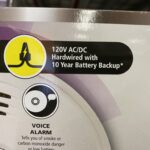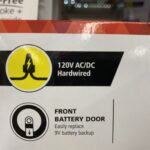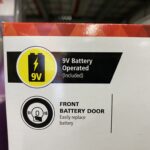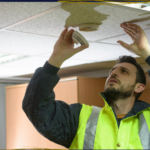Is it hot in here or is just us? INSPECT LV has a smokin' residential topic we would like to ignite awareness about...
According to the National Institute of Standards and Technology, approximately 96% of all homes in the U.S. have smoke alarms installed. However, approximately 1 out of 5 (20%) of installed smoke alarms are non-operational. It is estimated that residential fire deaths in the U.S. could drop by approximately 36% if every home had working smoke alarms! That is a staggering statistic.
So, let’s get familiar with the two different types of smoke alarms commonly found in the United States:
 Ionization smoke alarms contain a radioisotope. This radioisotope is typically Americium-241 and it is contained in an ionization chamber that acts as a shield to the alpha radiation it emits. The assembly ionizes the air, and if a potential difference due to smoke is detected, an audible alarm is sounded. For those of you freaked out by the thought of a radioactive material in your home, don’t worry. The radiological risk is negligible as long as the radioisotope is untouched in the ionization chamber. We are subjected to more significant amounts of natural background radiation day-to-day than a normally operating ionic smoke alarm produces. Research has indicated that ionizing smoke alarms are more sensitive to heat and react quicker to rapidly growing fires that are in the “flame” stage.
Ionization smoke alarms contain a radioisotope. This radioisotope is typically Americium-241 and it is contained in an ionization chamber that acts as a shield to the alpha radiation it emits. The assembly ionizes the air, and if a potential difference due to smoke is detected, an audible alarm is sounded. For those of you freaked out by the thought of a radioactive material in your home, don’t worry. The radiological risk is negligible as long as the radioisotope is untouched in the ionization chamber. We are subjected to more significant amounts of natural background radiation day-to-day than a normally operating ionic smoke alarm produces. Research has indicated that ionizing smoke alarms are more sensitive to heat and react quicker to rapidly growing fires that are in the “flame” stage.
 Photoelectric smoke alarms do not contain a radioisotope. Instead, they work by using sources of light such as infrared, visible or ultraviolet to monitor the surrounding air. If the intensity of the light being transmitted falls below a certain threshold as a result from scattering particulates, potentially caused by smoke, an audible alarm is then triggered by the circuitry to alert occupants of potential danger. According to research, optical (photoelectric) alarms are more sensitive to smoke, common with fires in the “early” or smoldering state.
Photoelectric smoke alarms do not contain a radioisotope. Instead, they work by using sources of light such as infrared, visible or ultraviolet to monitor the surrounding air. If the intensity of the light being transmitted falls below a certain threshold as a result from scattering particulates, potentially caused by smoke, an audible alarm is then triggered by the circuitry to alert occupants of potential danger. According to research, optical (photoelectric) alarms are more sensitive to smoke, common with fires in the “early” or smoldering state.
The National Fire Protection Association (NFPA) “is a global self-funded nonprofit organization, established in 1896. NFPA is devoted to eliminating death, injury, property and economic loss due to fire, electrical and related hazards” (https://www.nfpa.org/overview). They advise the installation of combination alarms, which use both the ionization and photoelectric smoke sensing methods for the best protection. Certain combination alarms may also include Carbon Monoxide (CO) detection ability.
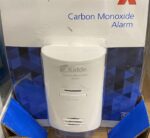 Carbon Monoxide (CO) alarms are designed to detect dangerous, and potentially fatal levels of CO in the home. Carbon monoxide is not naturally occurring, and is produced by incomplete burning of carbon fuel sources including but not limited to natural gas, propane, and gasoline. Surprisingly, the State of Nevada has only required installation of carbon monoxide alarms in all newly constructed homes since 2017. Another fun fact is that Nevada does not require installation or retrofitting of CO alarms in homes built prior to 2017. Regardless, Inspect LV highly encourages the installation of CO alarms in all homes, and in accordance with NFPA recommendations, even in homes that are all electric and have no carbon fuel utility.
Carbon Monoxide (CO) alarms are designed to detect dangerous, and potentially fatal levels of CO in the home. Carbon monoxide is not naturally occurring, and is produced by incomplete burning of carbon fuel sources including but not limited to natural gas, propane, and gasoline. Surprisingly, the State of Nevada has only required installation of carbon monoxide alarms in all newly constructed homes since 2017. Another fun fact is that Nevada does not require installation or retrofitting of CO alarms in homes built prior to 2017. Regardless, Inspect LV highly encourages the installation of CO alarms in all homes, and in accordance with NFPA recommendations, even in homes that are all electric and have no carbon fuel utility.
Q & A
Q: How often do smoke alarms and carbon monoxide alarms need to be replaced?
A: Smoke alarms should be replaced at least every 10 years. CO alarms and combination alarms should be replaced at least every 7 years. Certain smoke alarms now come factory equipped with a 10-year lithium-ion backup battery that doesn’t require replacement. Any replaceable battery (i.e., 9 volt) should be changed every 6 months. An easy way to remember this task is by doing it when the bi-annual time change occurs. Spring forward, Fall back!
Q: My house has hardwired smoke alarms. Can I replace them with battery operated ones?
A: If your home was originally equipped with wired smoke
alarms, they need to be replaced with the same type. In the absolute interest of safety, Inspect LV always recommends interconnection between all alarms in the home via wired connection or wireless technology such as Bluetooth. This way, when one sounds, they all sound.
Q: Do home inspectors test smoke alarms or carbon monoxide alarms?
A: It is important to know that Nevada State Licensed Inspectors of Structures are not required to test smoke alarms or carbon monoxide alarms, or even comment on the absence of them. However, an inspector may choose to exceed NAC645D, and review the aforementioned types of alarms and include pertinent information about those components or associated components in their report. The fact is that depressing the test button and hearing the audible alarm does not ensure that the smoke alarm will actually work properly in the event of an emergency. For this reason, many inspectors disclaim smoke alarms and CO alarms. Also, the presence of CO alarms is not always ascertainable.
Q: I have smoke alarms and carbon monoxide alarms installed in my house. An alarm is sounding… How do I know what is triggering the alarm?
A: Listen carefully, and you’ll be able to discern which threat is sounding the alarm.
- Smoke alarms beep
3 times (BEEP… BEEP… BEEP… PAUSE). - Carbon monoxide alarms beep 4 times (BEEP… BEEP… BEEP… BEEP…
PAUSE).
- Smoke alarms beep
Either way, it is important to have a family evacuation plan in place for emergency situations.
